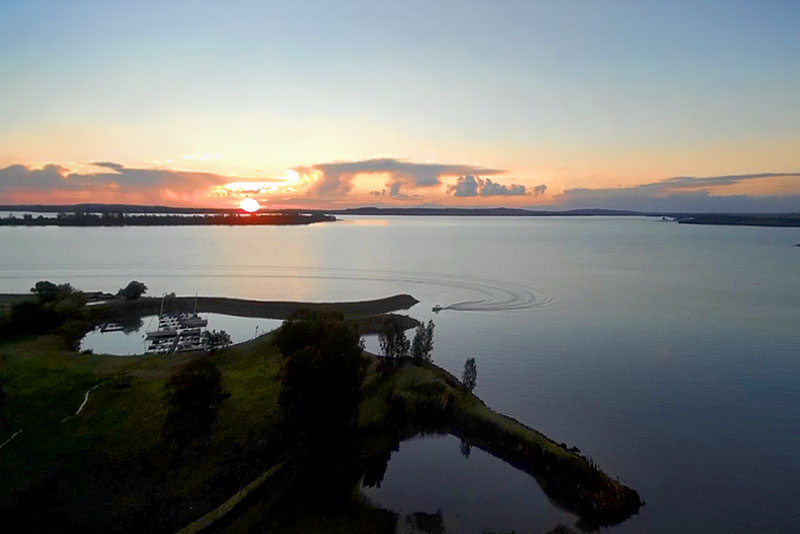Vaal Dam and River - Free State
Vaal Dam and River - Free State
The Vaal Dam, situated on the Vaal River in South Africa, is one of the country’s largest and most important reservoirs. Completed in 1938, the dam was primarily constructed to provide water for the burgeoning industrial needs of the Witwatersrand region, including Johannesburg. The Vaal Dam plays a crucial role in the country’s water management system, supplying water for both industrial use and domestic consumption, and regulating water flow to mitigate the effects of droughts and floods.
The Vaal River, which feeds into the dam, is one of South Africa's major rivers and forms an integral part of the country’s hydrological system. Originating in the central part of the country, the river flows southward and eventually joins the Oranje River. The Vaal River's watershed is vital for agricultural irrigation and maintaining ecosystems along its course. The dam and river together support a range of recreational activities, including boating, fishing, and watersports, making the area a popular destination for both locals and tourists.
The area around the Vaal Dam has been developed into a recreational hub, with various facilities and accommodations catering to visitors. The dam’s scenic surroundings, combined with its large expanse of water, offer opportunities for leisure and relaxation. Additionally, the Vaal Dam serves as a crucial ecological zone, supporting diverse wildlife and plant species. Its role in the region’s water supply and recreation underscores its significance in South Africa's environmental and economic landscape.
5 Facts about the Vaal Dam and River:
1. Completion Year: The Vaal Dam was completed in 1938 to provide water for industrial and domestic use, particularly in the Witwatersrand region.
2. Size and Capacity: The dam is one of South Africa’s largest reservoirs, with a total capacity of approximately 2.6 billion cubic meters of water.
3. Recreational Activities: The Vaal Dam is a popular destination for boating, fishing, and various watersports, attracting many visitors to its scenic shores.
4. Ecological Importance: The dam and the Vaal River support a diverse range of wildlife and plant species, contributing to the local ecosystem.
5. Water Management: The Vaal Dam plays a critical role in regulating water flow, helping to manage water resources and mitigate the impacts of droughts and floods in the region.
The Vaal River, one of South Africa's major rivers, stretches approximately 1,120 kilometers and serves as a crucial water source for the country. Originating in the highlands of the Gauteng province, it flows southwestward and eventually joins the Orange River near the border of the Northern Cape. The Vaal River plays a significant role in the South African water system, supplying water for agriculture, industry, and domestic use to a large portion of the country's population.
The river is also a popular recreational destination, with various activities such as fishing, boating, and water sports drawing visitors to its shores. Its picturesque scenery, combined with the presence of several reservoirs and dams along its course, makes the Vaal River a key feature of the region's landscape. The river's importance extends beyond its practical uses, contributing to local economies and providing a natural escape for outdoor enthusiasts.
3 Facts About the Vaal River:
1. Major Water Source: The Vaal River is a primary water source for Gauteng and other regions, crucial for agriculture, industry, and domestic supply.
2. Recreational Activities: It is a popular spot for fishing, boating, and water sports, attracting visitors to its scenic banks and reservoirs.
3. Length and Course: The river flows approximately 1,120 kilometers from its source in Gauteng to its confluence with the Orange River, significantly impacting the region's environment and economy.
Verblyf Naby Vaal Dam and River - Free State
Klipkraal Self Catering Guestfarm (Gasteplaas)
Self Catering House, Cottage, Chalet Accommodation in Heidelberg
13.3km from Vaal Dam and River - Free StateKlipkraalgastehuis - Hierdie selfsorg kothuise van die basiskamp en staproete is knus geleë tussen die heuwels van die Suikerbosrand. Die Klipkraal Gasteplaas bied die ideale toevlugsoord weg van die gejaag en geraas van die stadslewe. …sien meer vir besprekings / navrae en inligting.

 Sunset taken at the Vaal Dam ©
Sunset taken at the Vaal Dam © 

